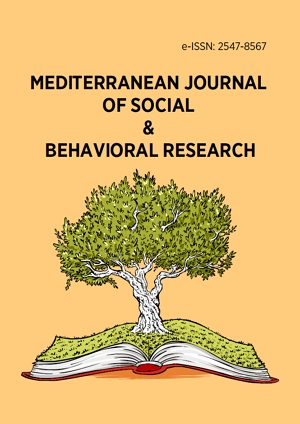Research Article
Factors affecting research motivation among lecturers in the Institute of Teacher Education
More Detail
1 Department of Planning, Research and Innovation, Institute of Teacher Education, Cyberjaya, MALAYSIA* Corresponding Author
Mediterranean Journal of Social & Behavioral Research, 8(2), June 2024, 55-60, https://doi.org/10.30935/mjosbr/14436
Published Online: 04 April 2024, Published: 01 May 2024
OPEN ACCESS 689 Views 233 Downloads
ABSTRACT
Motivation to conduct research among lecturers is an important issue that needs to be addressed to ensure that the research culture at the Institute of Teacher Education (ITE) can be nurtured. This study was conducted to identify factors that influence research motivation among lecturers at ITE. This study uses a correlational study design involving a total of 271 lecturers. The selection of the sample is carried out by using a clustered random sampling method. Data was collected using a questionnaire adapted from previous studies. Statistical package for social science and SmartPLS version 3.0 software were used to analyze the data. Findings from the analysis that has been conducted shows that the efficacy belief factor (β=0.312, p<0.001) and institutional support (β=0.230, p<0.001) have influenced the intrinsic motivation to conduct research. Meanwhile, the efficacy belief factor (β=0.353, p<0.001) and institutional support (β=0.187, p<0.001) also influenced the extrinsic motivation to conduct research directly. Overall, the factors studied explained 21.4% and 21.8% of the variance in intrinsic and extrinsic motivation to conduct research among lecturers at ITE. The findings of this study can be used by various parties to improve the aspect of increasing research motivation among lecturers.
CITATION (APA)
Abdul Rahman, M. N. (2024). Factors affecting research motivation among lecturers in the Institute of Teacher Education. Mediterranean Journal of Social & Behavioral Research, 8(2), 55-60. https://doi.org/10.30935/mjosbr/14436
REFERENCES
- Bailey, J. G. (1999). Academics’ motivation and self-efficacy for teaching and research. International Journal of Phytoremediation, 21(1), 343-359. https://doi.org/10.1080/0729436990180305
- Breen, R., & Lindsay, R. (1999). Academic research and student motivation. Studies in Higher Education, 24(1), 75-93. https://doi.org/10.1080/03075079912331380158
- Cha, E. S., Kim, K. H., & Erlen, J. A. (2007). Translation of scales in cross-cultural research: Issues and techniques. Journal of Advanced Nursing, 58(4), 386-395. https://doi.org/10.1111/j.1365-2648.2007.04242.x
- Cohen, L., Manion, L., & Morrison, K. (2011). Research methods in education. Routledge.
- Creswell, J. W. (2014). Research design: Qualitative, quantitative, and mixed methods approaches (4th edn.). SAGE Publications Ltd. https://doi.org/10.1007/s13398-014-0173-7.2
- Erdfelder, E. (2009). Statistical power analyses using G*Power 3.1. Behavior Research Methods, 41(4), 1149-1160. https://doi.org/10.3758/BRM.41.4.1149
- Fornell, C., & Larcker, D. F. (1981). Evaluating structural equation models with unobservable variables and measurement error. Journal of Marketing Research, 18(1), 39. https://doi.org/10.2307/3151312
- Hair, J. F., Ringle, C. M., & Sarstedt, M. (2011). PLS-SEM: Indeed a silver bullet. Journal of Marketing Theory and Practice, 19(2), 139-152. https://doi.org/10.2753/MTP1069-6679190202
- Henseler, J., Ringle, C. M., & Sinkovics, R. R. (2015). The use of partial least squares path modeling in international marketing. In R. R. Sinkovics, & P. N. Ghauri (Eds.), New challenges to international marketing (advances in international marketing) (pp. 277-319). Emerald Group Publishing Limited. https://doi.org/10.1108/S1474-7979(2009)0000020014
- Hosseini, M., & Bahrami, V. (2020). Adaptation and validation of the research motivation scale for language teachers. Journal of Experimental Education, 90(1), 229-248. https://doi.org/10.1080/00220973.2019.1709036
- Hulland, J. (2002). Use of partial least squares (PLS) in strategic management research: A review of four recent studies. Strategic Management Journal, 8(2), 195-204. https://doi.org/10.1002/smj.43l
- Jöreskog, K. G. (1978). Structural analysis of covariance and correlation matrices. Psychometrika, 43(4), 443-477. https://doi.org/10.1007/BF02293808
- Kementerian Pendidikan Malaysia [Malaysia Education Ministry]. (2016). Deskripsi tugas pegawai perkhidmatan pendidikan [Education service officer job description]. https://www.moe.gov.my/dasar/1199-deskripsi-tugas-pegawai-perkhidmatan-pendidikan-kpm-laluan-pdp-dan-kepimpinan-edisi-2016/file
- Kementerian Pendidikan Malaysia [Malaysia Education Ministry]. (2017). Tranformasi Institut Pendidikan Guru 2016-2025 [Transformation of the Teacher Education Institute 2016-2025].
- Kerlinger, F. N. (1986). Foundations of behavioral research. Wadsworth Publishing.
- Kuo, P. B., Woo, H., & Bang, N. M. (2017). Advisory relationship as a moderator between research self-efficacy, motivation, and productivity among counselor education doctoral students. Counselor Education and Supervision, 56(2), 130-144. https://doi.org/10.1002/ceas.12067
- Lepper, M. R., Greene, D., & Nisbett, R. E. (1973). Undermining children’s intrinsic interest with extrinsic reward: A test of the “overjustification” hypothesis. Journal of Personality and Social Psychology, 28(1), 129-137. https://doi.org/10.1037/h0035519
- Nunnally, J., & Bernstein, I. (1994). Psychometric theory. McGraw-Hill.
- Peng, J. E., & Gao, X. (Andy). (2019). Understanding TEFL academics’ research motivation and its relations with research productivity. SAGE Open, 9(3). https://doi.org/10.1177/2158244019866295
- Ryan, R. M. (1995). Psychological needs and the facilitation of integrative processes. Journal of Personality, 63, 397. https://doi.org/10.1111/j.1467-6494.1995.tb00501.x
- Ryan, R. M., & Deci, E. L. (2000). Self-determination theory and the facilitation of intrinsic motivation, social development, and well-being. American Psychologist, 55(1), 68-78. https://doi.org/10.1037/0003-066X.55.1.68
- Sanchez-Franco, M. J., & Roldán, J. L. (2010). Expressive aesthetics to ease perceived community support: Exploring personal innovativeness and routinised behavior as moderators in Tuenti. Computers in Human Behavior, 26(6), 1445-1457. https://doi.org/10.1016/j.chb.2010.04.023
- Stupnisky, R. H., BrckaLorenz, A., & Laird, T. F. N. (2019). How does faculty research motivation type relate to success? A test of self-determination theory. International Journal of Educational Research, 98, 25-35. https://doi.org/10.1016/j.ijer.2019.08.007
- Tien, F. F., & Blackburn, R. T. (1996). Faculty rank system, research motivation, and faculty research productivity: Measure refinement and theory testing. Journal of Higher Education, 67(1), 2-22. https://doi.org/10.1080/00221546.1996.11780246
- Weiner, B. (1990). History of motivational research in education. Journal of Educational Psychology, 82(4), 616-622. https://doi.org/10.1037/0022-0663.82.4.616
- Wold, H. (1974). Causal flows with latent variables: Partings of the ways in the light of NIPALS modelling. European Economic Review, 5(1), 67-86. https://doi.org/10.1016/0014-2921(74)90008-7
- Zhang, J., Cao, C., Shen, S., & Qian, M. (2019). Examining effects of self-efficacy on research motivation among Chinese university teachers: Moderation of leader support and mediation of goal orientations. Journal of Psychology: Interdisciplinary and Applied, 153(4), 414-435. https://doi.org/10.1080/00223980.2018.1564230

 The articles published in this journal are licensed under the CC-BY Creative Commons Attribution International License.
The articles published in this journal are licensed under the CC-BY Creative Commons Attribution International License.